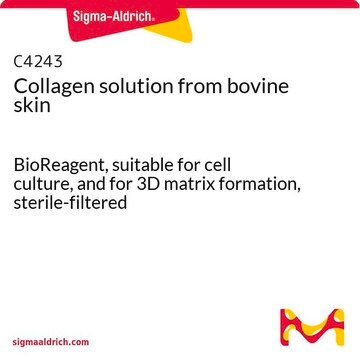08-115
Rat Collagen Type I
from rat tail, liquid, 2-5 mg/mL, suitable for cell culture, used for 3D gel formation
Synonym(s):
Rat tail collagen, Rat tail collagen type I
About This Item
Recommended Products
product name
Collagen Type I, rat tail,
biological source
rat
Quality Level
form
liquid
manufacturer/tradename
Upstate®
technique(s)
cell culture | mammalian: suitable
input
sample type hematopoietic stem cell(s)
sample type mesenchymal stem cell(s)
sample type induced pluripotent stem cell(s)
sample type epithelial cells
sample type pancreatic stem cell(s)
sample type neural stem cell(s)
sample type: mouse embryonic stem cell(s)
NCBI accession no.
UniProt accession no.
shipped in
wet ice
storage temp.
2-8°C
Gene Information
rat ... COL1A1(29393)
General description
Application
- for collagen 3D proliferation assays
- for atelocollagen proliferation assays
- in a comparative study to make microcapsules for templating on mesoporous cores of pure vaterite calcium carbonate (CaCO3) crystals to evaluate the structure-property relationship
- in coverslip coating to grow the human cerebral microvascular endothelial cell line (hCMEC/D3) for creating a cell coculture and chronic subdural hematoma (CSDH) patient hematoma sample induced injury model
Biochem/physiol Actions
Quality
Physical form
Storage and Stability
Legal Information
Disclaimer
Storage Class Code
12 - Non Combustible Liquids
WGK
WGK 1
Flash Point(F)
Not applicable
Flash Point(C)
Not applicable
Certificates of Analysis (COA)
Search for Certificates of Analysis (COA) by entering the products Lot/Batch Number. Lot and Batch Numbers can be found on a product’s label following the words ‘Lot’ or ‘Batch’.
Already Own This Product?
Find documentation for the products that you have recently purchased in the Document Library.
Customers Also Viewed
Protocols
Discover our collection of primary human hepatic Kupffer cells and protocol for thawing, plating, and growing Kupffer cells. Find the formulation for Kupffer culture maintenance media.
Discover our collection of primary human hepatic Kupffer cells and protocol for thawing, plating, and growing Kupffer cells. Find the formulation for Kupffer culture maintenance media.
Discover our collection of primary human hepatic Kupffer cells and protocol for thawing, plating, and growing Kupffer cells. Find the formulation for Kupffer culture maintenance media.
Discover our collection of primary human hepatic Kupffer cells and protocol for thawing, plating, and growing Kupffer cells. Find the formulation for Kupffer culture maintenance media.
Related Content
Discover our collection of primary human hepatic stellate cells and protocol for thawing, plating, and growing stellate cells. Find our stellate culture maintenance media formulation.
Discover our collection of primary human hepatic stellate cells and protocol for thawing, plating, and growing stellate cells. Find our stellate culture maintenance media formulation.
Discover our collection of primary human hepatic stellate cells and protocol for thawing, plating, and growing stellate cells. Find our stellate culture maintenance media formulation.
Discover our collection of primary human hepatic stellate cells and protocol for thawing, plating, and growing stellate cells. Find our stellate culture maintenance media formulation.
Our team of scientists has experience in all areas of research including Life Science, Material Science, Chemical Synthesis, Chromatography, Analytical and many others.
Contact Technical Service









